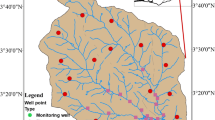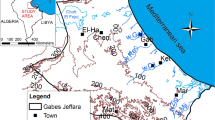Abstract
The hydrologic characteristics of the Oak Openings Region in northwest Ohio, USA, a globally rare ecosystem are not well understood. Currently, the Oak Openings supports globally rare oak savanna and wet prairie habitats. The wet prairies in the region have been drained by ditches and encroached by invasive plants, which have altered the natural flow making it an unusually variable and artificial system. A shallow groundwater model was implemented using the Gridded Surface Subsurface Hydrologic Analysis (GSSHA) software to simulate continuous, long-term groundwater and surface water interaction in a small subwatershed in the Oak Openings Region. The implemented GSSHA model simulates physical processes such as infiltration, evapotranspiration, snowmelt, overland flow, and interaction of groundwater with ditches. The model was calibrated using a time series of water table elevations collected in the field. Although the model tends to slightly underestimate water table elevations (mean and standard deviation percent differences of less than 1%), statistical analysis indicate a good fit between observed and simulated water table elevations (Nash Sutcliffe Efficiency Index of 0.78). The model would be a useful tool for the preservation of natural areas such as wet prairies.








Similar content being viewed by others
References
Abella SR, Jaeger JF, Gehring DH, Jacksy RG, Menard KS, High K (2001) Restoring historic plant communities in the Oak Openings region of northwest Ohio. Ecol Restor 19:155–160
Ajami H, Evans JP, McCabe MF, Stisen S (2014) Reducing the spin-up time of integrated surface water–groundwater models. Hydrol Earth Syst Sci 18:5169–5179
Allen RG, Pereira LS, Raes D, Smith M (1998) FAO irrigation and drainage paper no. 56. Crop evapotranspiration. FAO, Rome
Anderson MP, Woessner WW (1992) The role of the postaudit in model validation. Adv Water Resour 15:167–173
Aquaveo LLC (2016) WMS, The Watershed Modeling System (2016), version 10.0.13, Provo, UT. http://www.aquaveo.com/WMS
Bachmat Y (1978) Utilization of numerical groundwater models for water resource management (vol 78, no. 12). Environmental Protection Agency, Office of Research and Development, Robert S. Kerr Environmental Research Laboratory
Becker RH, Zmijewski KA, Crail T (2013) Seeing the forest for the invasives: mapping buckthorn in the Oak openings. Biol Invasions 15:315–326
Boulton AJ, Findlay S, Marmonier P et al (1998) The functional significance of the hyporheic zone in streams and rivers. Annu Rev Ecol Syst 29:59–81
Brewer LG, Vankat JL (2004) Description of vegetation of the oak openings of northwestern Ohio at the time of Euro-American settlement. Ohio J Sci 104:76–85
Chow VT (1959) Open channel hydraulics. McGraw-Hill, New York
Cohen JE (1986) Population forecasts and confidence intervals for Sweden: a comparison of model-based and empirical approaches. Demography 23:105–126
D’Angelo DJ, Webster JR, Gregory SV, Meyer JL (1993) Transient storage in Appalachian and Cascade mountain streams as related to hydraulic characteristics. J North Am Benthol Soc 12:223–235
Dent JB, Blackie MJ (1979) Model-Evaluation. Systems simulation in agriculture. Springer, London, pp 94–117
Downer CW, Ogden FL (2004) GSSHA: model to simulate diverse stream flow producing processes. J Hydrol Eng 9:161–174
Downer CW, James WF, Byrd A, Eggers GW (2002a) Gridded surface subsurface hydrologic analysis (GSSHA) model simulation of hydrologic conditions and restoration scenarios for the Judicial Ditch 31 Watershed, Minnesota. DTIC Document
Downer CW, Ogden FL, Martin WD, Harmon RS (2002b) Theory, development, and applicability of the surface water hydrologic model CASC2D. Hydrol Process 16:255–275
Downer CW, Pradhan NR, Skahill BE et al (2014) Simulating the effects of drainage and agriculture on hydrology and sediment in the Minnesota River Basin. In: AGU Fall Meeting Abstracts, pp 1166
Elderhorst WIM (1984) The role of modelling in the development of African groundwater resources. IAHS-AISH Publ, pp 185–191
Eyster T (2013) Stream restoration on the Princeton University campus. Undergraduate Senior Thesis, Princeton University
Findlay S (1995) Importance of surface-subsurface exchange in stream ecosystems: the hyporheic zone. Limnol Oceanogr 40:159–164
Follum ML, Downer CW (2013) Snow water equivalent modeling capabilities of the GSSHA watershed model (No. ERDC/CHL-TR-13-4). Engineer Research and Development Center, Coastal and Hydraulic Laboratory, Vicksburg
Forsyth JL (1970) A geologist looks at the natural vegetation map of Ohio. Ohio J Sci 70:180–191
Gardner R, Haase G (2004) Plant communities of the Oak Openings. In: Grigore MT (ed) Living in the Oak openings: a homeowner’s guide to one of the world’s last great places. The nature conservancy. Homewood Press, Toledo, pp 11–15
Gomezdelcampo E, Coode K (2013) Hydrologic Monitoring of a wet prairie restoration in the Oak Openings Region, Ohio, USA. In AGU Meeting of the Americas Abstracts, pp 71
Gowdish LC (2007) An improved Green-Ampt soil infiltration and redistribution method and its application to 1-dimensional and quasi 3-dimensional (point source) flow domains. Dissertation, University of Florida
Grigore MT (2004) Geology and its role in plant communities of the Oak Openings Region. In: Grigore MT (ed) Living in the Oak Openings: a homeowner’s guide to one of the world’s last great places. The Nature Conservancy. Homewood Press, Toledo, pp 5–9
Harvey JW, Bencala KE (1993) The effect of streambed topography on surface-subsurface water exchange in mountain catchments. Water Resour Res 29:89–98
Heneghan L, Fatemi F, Umek L et al (2006) The invasive shrub European buckthorn (Rhamnus cathartica, L.) alters soil properties in Midwestern US woodlands. Appl Soil Ecol 32:142–148
Hu L-T, Wang Z-J, Tian W, Zhao J-S (2009) Coupled surface water–groundwater model and its application in the Arid Shiyang River basin, China. Hydrol Process 23:2033–2044
Jain SK, Sudheer KP (2008) Fitting of hydrologic models: a close look at the Nash–Sutcliffe index. J Hydrol Eng 13:981–986
Jenkins RN (2006) The uses of GSSHA to model groundwater-surface water interaction. Master’s Thesis, Brigham Young University
Jobson HE, Harbaugh AW (1999) Modifications to the diffusion analogy surface-water flow model (DAFLOW) for coupling to the modular finite-difference ground-water flow model (MODFLOW). US Geological Survey Open-File Report, pp 99–217
Julien PY, Saghafian B, Ogden FL (1995) Raster-based hydrologic modeling of spatially varied surface runoff. J Am Water Res Assoc 31:523–536
Krause P, Boyle DP, Bäse F (2005) Comparison of different efficiency criteria for hydrological model assessment. Adv Geosci 5:89–97
Larson E. Wu J, McCool D (2004) Continuous Frozen Ground Index (CFGI) as an indicator for high erosion frozen soil events: Washington State University. Center for Multiphase Environmental Research Technical Report
Lautz LK, Siegel DI (2006) Modeling surface and ground water mixing in the hyporheic zone using MODFLOW and MT3D. Adv Water Resour 29:1618–1633
Lautz LK, Siegel DI, Bauer RL (2006) Impact of debris dams on hyporheic interaction along a semi-arid stream. Hydrol Process 20:183–196
Legates DR, McCabe GJ (1999) Evaluating the use of “goodness-of-fit” measures in hydrologic and hydroclimatic model validation. Water Resour Res 35:233–241
Marsik M, Waylen P (2006) An application of the distributed hydrologic model CASC2D to a tropical montane watershed. J Hydrol 330:481–495
Mayer DG, Butler DG (1993) Statistical validation. Ecol Model 68:21–32
Mayfield H (1969) Changes in the natural history of the Toledo region since the coming of the white man. Toledo Area Aborig Res Club Bull 1:11–31
McDonald MG, Harbaugh AW (1984) A modular three-dimensional finite-difference ground-water flow model. US Geological Survey Open-File Report, pp 83–875
McElwee CD, Yukler MA (1978) Sensitivity of groundwater models with respect to variations in transmissivity and storage. Water Resour Res 14:451–459
Molnau M, Bissell VC (1983) A continuous frozen ground index for flood forecasting. In: Proceedings 51st Annual Meeting Western Snow Conference. Canadian Water Resources Assoc. Cambridge, Ont, pp 109–119
Morrice JA, Valett HM, Dahm CN, Campana ME (1997) Alluvial characteristics, groundwater–surface water exchange and hydrological retention in headwater streams. Hydrol Process 11:253–267
Moseley EL (1928) Flora of the Oak Openings. In: Proc. Ohio Academy of Sciences Special Paper, No. 20, vol 8, pp 81–134
Nash JE, Sutcliffe JV (1970) River flow forecasting through conceptual models part I—a discussion of principles. J Hydrol 10:282–290
Nemeth MS, Wilcox WM, Solo-Gabriele HM (2000) Evaluation of the use of reach transmissivity to quantify leakage beneath Levee 31N, Miami-Dade County, Florida. US Geological Survey Water-Resources Investigations Report 00-4066
Ogden FL, Byrd AR, Downer CW, Johnson BE (2008) TMDL watershed analysis with the physics-based hydrologic, sediment transport, and contaminant transport model GSSHA. In: ASCE World Environmental and Water Resources Congress 2008. https://doi.org/10.1061/40976(316)450
Palmer WC (1965) Meteorological drought. US Department of Commerce, Weather Bureau Res. Paper, pp 45
Picard RR, Cook RD (1984) Cross-validation of regression models. J Am Stat Assoc 79:575–583
Restrepo JI, Montoya AM, Obeysekera J (1998) A wetland simulation module for the MODFLOW ground water model. Ground Water 36:764–770
Schetter TA, Root KV (2011) Assessing an imperiled oak savanna landscape in northwestern Ohio using Landsat data. Nat Areas J 31:118–130
Sears PB (1926) The natural vegetation of Ohio II. The prairies. Ohio J Sci 26:128–146
Shade JW, Valkenberg N (1975) Comparison of base flow and groundwater chemistry, Oak openings sand, Lucas County, Ohio. Ohio J Sci 75:138–146
Shaeffer DL (1980) A model evaluation methodology applicable to environmental assessment models. Ecol Model 8:275–295
Siegel JS (1972) Development and accuracy of projections of population and households in the United States. Demography 9:51–68
Smith SK (1987) Tests of forecast accuracy and bias for county population projections. J Am Stat Assoc 82:991–1003
Smith RE, Corradini C, Melone F (1993) Modeling infiltration for multistorm runoff events. Water Resour Res 29:133–144
Swain ED (1994) Implementation and use of direct-flow connections in a coupled ground-water and surface-water model. Ground Water 32:139–144
Swain ED, Wexler EJ (1996) A coupled surface-water and ground-water flow model (MODBRANCH) for simulation of stream-aquifer interaction. US Geological Survey Techniques of Water-Resources Investigations Report 06-A6
Tryon CA, Easterly NW (1975) Plant communities of the Irwin Prairie and adjacent wooded areas. Castanea 201–213
USDA SCS (1980) US Department of Agriculture Soil Conservation Service, Soil Survey of Lucas County, Ohio. Washington, DC
USGS NLCD (2011) US Geological Survey National Land Cover Database http://www.mrlc.gov/nlcd2011.php. Accessed 21 Oct 2014
Weston DM, Skahill BE, Downer CW et al (2015) Gridded surface subsurface hydrologic analysis modeling for analysis of flood design features at the Picayune Strand restoration project. In: ASCE World Environmental and Water Resources Congress 2015. pp 1500–1511
Willmott CJ (1981) On the validation of models. Phys Geogr 2:184–194
Willmott CJ (1984) On the evaluation of model performance in physical geography. In: Gaile GL, Willmott CJ (eds) Spatial statistics and models. Springer, Dordrecht, pp 443–460
Willmott CJ, Ackleson SG, Davis RE, Feddema JJ, Klink KM, Legates DR, O’Donnell J, Rowe CM (1985) Statistics for the evaluation and comparison of models. J Geophys Res Oceans 90:8995–9005
Wroblicky GJ, Campana ME, Valett HM, Dahm CN (1998) Seasonal variation in surface-subsurface water exchange and lateral hyporheic area of two stream-aquifer systems. Water Resour Res 34:317–328
Zhai J, Su B, Krysanova V, Vetter T, GAO C, Jiang T (2010) Spatial variation and trends in PDSI and SPI indices and their relation to streamflow in 10 large regions of China. J Clim 23:649–663
Acknowledgements
The work for this manuscript was performed while the first author, Dayal Buddika Wijayarathne, was a graduate student at Bowling Green State University. Funding from The Nature Conservancy for another project (OHFO-GLRI-BGSU-10/10 − 02) allowed for the collection of field data used in the calibration and testing of the GSSHA model in this study.
Author information
Authors and Affiliations
Corresponding author
Additional information
Publisher’s Note
Springer Nature remains neutral with regard to jurisdictional claims in published maps and institutional affiliations.
Rights and permissions
About this article
Cite this article
Wijayarathne, D.B., Gomezdelcampo, E. Using shallow groundwater modeling to frame the restoration of a wet prairie in the Oak Openings Region, Ohio, USA: GSSHA model implementation. Environ Earth Sci 78, 216 (2019). https://doi.org/10.1007/s12665-019-8208-1
Received:
Accepted:
Published:
DOI: https://doi.org/10.1007/s12665-019-8208-1




